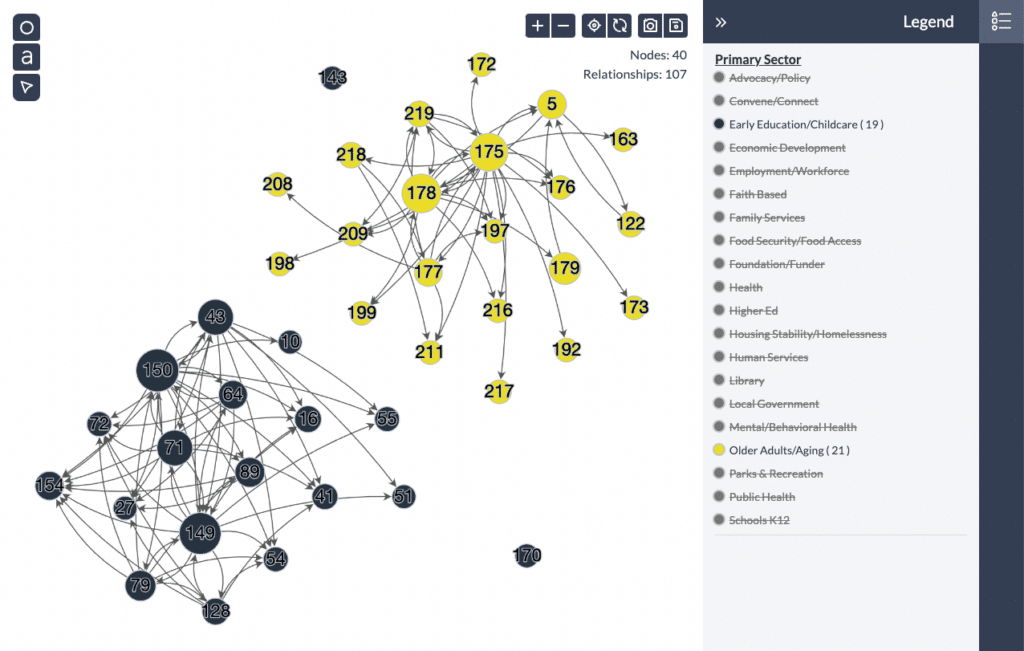Collaboration is essential for solving complex challenges. Whether in public health, philanthropy, or community development, partnerships bring together diverse expertise, resources, and perspectives. However, too much collaboration can become a problem.
Collaboration overload occurs when organizations manage too many partnerships at once, leading to inefficiencies, misalignment, and burnout. Instead of increasing impact, excessive collaboration can slow decision-making, drain resources, and reduce effectiveness.
This article will explore:
- What collaboration overload is and why it happens
- The hidden costs of too many partnerships
- How to use network science to optimize collaboration
- How PARTNER CPRM helps organizations build more strategic and effective partnerships
Table of Contents
What Is Collaboration Overload?
Collaboration overload happens when organizations stretch themselves too thin by managing an excessive number of partnerships. While the intention may be to expand impact, the reality is that not all collaborations are equally valuable or necessary.
Common signs of collaboration overload include:
- Frequent, unproductive meetings that do not lead to action
- Email chains involving too many stakeholders with unclear next steps
- Redundant efforts due to a lack of coordination
- Difficulty tracking and measuring the impact of partnerships
- Staff burnout caused by excessive time spent managing relationships
Collaboration should enhance efficiency, but when too many partnerships require attention, the result is often lost time and resources.

The Hidden Costs of Too Many Partnerships
Many organizations assume that more partnerships lead to greater impact. In reality, the opposite can be true. Leaders in the nonprofit, public health, and philanthropic sectors spend a significant portion of their time managing collaborations, yet many of these efforts fail to produce meaningful results.
Here’s how excessive collaboration can harm an organization:
- Time Drain – Managing multiple partnerships requires meetings, coordination, and communication, pulling staff away from core programmatic work.
- Decision Paralysis – Too many voices at the table can slow decision-making and create misalignment.
- Resource Waste – Redundant partnerships lead to duplicated efforts, inefficient funding allocation, and unnecessary administrative burdens.
- Staff Burnout – Teams stretched too thin across multiple partnerships experience stress, reduced productivity, and disengagement.
- Unmeasured Impact – Without a clear strategy for evaluating partnerships, organizations struggle to determine which relationships drive meaningful results.
Rather than striving for more partnerships, organizations should focus on high-value collaborations that contribute to their mission.

Get our monthly newsletter with resources for cross-sector collaboration, VNL recommended reading, and upcoming opportunities for engaged in the “network way of working.”
The Solution: Smarter, Strategic Collaboration with Network Science
Instead of asking, “How can we collaborate more?” organizations should be asking, “Which partnerships matter most?”
This is where network science becomes invaluable. Instead of treating every relationship as equal, Social Network Analysis (SNA) helps organizations map their networks, assess the quality of relationships, and focus on the connections that yield the greatest impact.
Using PARTNER CPRM, organizations can:
- Visualize their network – Identify key players, understand existing relationships, and find gaps in collaboration.
- Assess trust and value – Measure which partnerships provide the most strategic benefits and where efforts may be misallocated.
- Optimize collaboration – Shift from managing many partnerships to focusing on the most impactful relationships.
- Measure impact over time – Track how relationships evolve and adapt strategies accordingly.
Strategic collaboration is not about working with the most people—it is about working with the right people.

This example from the PARTNER CPRM analyzer demonstrates how two sub-networks (the Early Childhood sector, and the older adults sector) were completely disconnected from each other.
These silos represent an opportunity to identify and leverage trusted bridge nodes in the community to bring them together and establish several working relationships based on mission alignment, resource needs, and organizational compatibility.
How PARTNER CPRM Helps Organizations Reduce Collaboration Overload
PARTNER CPRM is designed to help organizations manage and optimize their networks more effectively. Unlike traditional CRMs, which track one-to-one interactions, PARTNER CPRM provides insights into entire ecosystems of partnerships.
Key features include:
- Network Mapping – Visually understand the structure and dynamics of your partnership network.
- Trust & Value Scores – Identify which relationships contribute the most value to your organization’s mission.
- Strategic Insights – Make data-driven decisions about where to invest resources and which partnerships to prioritize.
- Impact Tracking – Monitor changes in collaboration over time to ensure sustainability and effectiveness.
By reducing unnecessary collaboration and focusing on high-impact relationships, organizations can work more efficiently, improve outcomes, and reduce staff burnout.
Final Thoughts: Less Is More in Collaboration
More collaboration does not always mean more impact. Many organizations struggle with collaboration overload, spending valuable time and resources on partnerships that may not be strategically necessary.
dBy applying network science and tools like PARTNER CPRM, organizations can:
- Reduce time spent on redundant collaboration
- Strengthen relationships that offer real value
- Improve decision-making and strategic alignment
- Avoid staff burnout and inefficiencies
Strategic collaboration is about focusing on what works, not just increasing the number of partnerships. Organizations that take a data-driven approach can maximize their impact while avoiding the pitfalls of excessive collaboration.
Learn More About Smarter Collaboration
Are you ready to reduce collaboration overload and focus on what matters most?
Schedule a demo of PARTNER CPRM today and take the first step toward smarter, more strategic collaboration.







